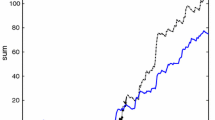Abstract
This paper proposes a multi-channel quickest detection method based on compressed sensing and short-time Fourier transform. Quickest detection performs a statistical test to obtain the minimal detection delay subject to given false alarm constrains. Short-time Fourier transform, which reflects the time–frequency information, implements the multi-channel quickest detection. Compressed sensing reduces the sampling rate at first. Compared with single-channel spectrum sensing, this method substantially improves the spectrum access opportunity in time and frequency domain. The relationship between the detection delay and other parameters, such as the probability of false alarm, SNR, sparsity, and sampling rate, verifies the validity of the method. While simulation results show that this method can perform spectrum sensing in high detection probability and low probability of false alarm.







Similar content being viewed by others
References
Poor, H. V., & Hadjiliadis, O. (2009). Quickest detection. Cambridge: Cambridge University Press.
Li, H., Li, C., & Dai, H. (2008). Quickest spectrum sensing in cognitive radio. Information sciences and system, 2008. 42nd Annual conference on. IEEE, pp. 203–208.
Li, H. (2010). Cyclostationary feature based quickest spectrum sensing in cognitive radio systems. Vehicular technology conference Fall (VTC 2010-Fall), 2010 IEEE, pp. 1–5.
Urkowitz, H. (1967). Energy detection of unknown deterministic signals. Proceedings of the IEEE, 55(4), 523–531.
Cabric, D. (2004). Implementation issues in spectrum sensing for cognitive radios. Signals, systems and computers, 2004. Conference record of the thirty-eighth Asilomar conference on. IEEE, 1, 772–776.
Gardner, W. A. (1988). Signal interception: A Uni-fying theoretical framework for feature detection. IEEE Transactions on Communications, 36(8), 897–906.
Lai, L., Fan, Y., & Poor, H. V. (2008). Quickest detection in cognitive radio: A sequential change detection framework. Global telecommunications conference, 2008. IEEE GLOBECOM 2008. IEEE, IEEE, pp. 1–5.
Page, E. S. (1954). Continuous inspection schemes. Biometrika, 41, 100–115.
Candès, E. J. (2008). The restricted isometry property and its implications for compressed sensing. Comptes Rendus Mathematique, 346(9), 589–592.
Baraniuk, R. (2007). Compressive sensing. IEEE Signal Processing Magazine, 24(4), 118–121.
Candès, E. J., Romberg, J., & Tao, T. (2006). Robust uncertainty principles: Exact reconstruction from highly incomplete frequency information. IEEE Transactions on Information Theory, 52(2), 489–509.
Tropp, J. A., & Gilbert, A. C. (2005). Signal recovery from partial information via orthogonal matching pursuit. Preprint, University of Michigan.
Author information
Authors and Affiliations
Corresponding author
Rights and permissions
About this article
Cite this article
Zhao, Q., Li, X. & Wu, Z. Quickest Detection of Multi-channel Based on STFT and Compressed Sensing. Wireless Pers Commun 77, 2183–2193 (2014). https://doi.org/10.1007/s11277-014-1632-3
Published:
Issue Date:
DOI: https://doi.org/10.1007/s11277-014-1632-3




